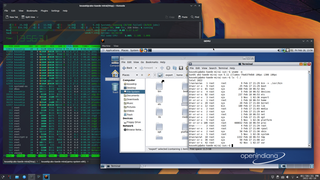This article has multiple issues. Please help improve it or discuss these issues on the talk page . (Learn how and when to remove these messages)
|
Virtue is a virtual session manager running under IBM's VM operating system. [1]
This article has multiple issues. Please help improve it or discuss these issues on the talk page . (Learn how and when to remove these messages)
|
Virtue is a virtual session manager running under IBM's VM operating system. [1]
Virtue, short for "virtual tube", was the first session manager commercially available for the VM environment on IBM mainframes. The product allows users to use a standard 3270 monitor to control multiple sessions, whether VM/CMS, DOS/VSE, z/VSE MVS, z/OS, or other operating systems or applications such as CICS, Westi, or DUCS sessions. Virtue runs as a highly privileged CMS task, designed to accommodate model IBM 3270 monitors and their descendants. [2]
Product development occurred at III offices within Westinghouse Automation Intelligence division, Orlando, Florida, United States. Broad range in-depth testing was conducted at IBM's data center in Tampa, Florida, and the IBM lab in Böblingen, Germany. Although the package nominally ran as a highly privileged CMS session and utilized CMS services, it deployed an internal multitasking mechanism called a "subvisor", which queued and prioritized tasks to be done. [2]
Westinghouse Electric acquired the marketing rights in various regions.
After release, a number of competing products entered the market, including MultiTerm and Computer Associates' vTerm, also known as vGraf. The concept found its way onto early PC platforms at the time, notably Apple Computer's Switcher for the Macintosh and subsequent products for the IBM PC.
IBM mainframes are large computer systems produced by IBM since 1952. During the 1960s and 1970s, IBM dominated the computer market with the 7000 series and the later System/360, followed by the System/370. Current mainframe computers in IBM's line of business computers are developments of the basic design of the System/360.

VSEn is an operating system for IBM mainframe computers, the latest one in the DOS/360 lineage, which originated in 1965. It is less common than z/OS and is mostly used on smaller machines.

The Conversational Monitor System is a simple interactive single-user operating system. CMS was originally developed as part of IBM's CP/CMS operating system, which went into production use in 1967. CMS is part of IBM's VM family, which runs on IBM mainframe computers. VM was first announced in 1972, and is still in use today as z/VM.
In computing, Interactive System Productivity Facility (ISPF) is a software product for many historic IBM mainframe operating systems and currently the z/OS and z/VM operating systems that run on IBM mainframes. It includes a screen editor, the user interface of which was emulated by some microcomputer editors sold commercially starting in the late 1980s, including SPF/PC.

VM is a family of IBM virtual machine operating systems used on IBM mainframes System/370, System/390, zSeries, System z and compatible systems, including the Hercules emulator for personal computers.

CP/CMS is a discontinued time-sharing operating system of the late 1960s and early 1970s. It is known for its excellent performance and advanced features. Among its three versions, CP-40/CMS was an important 'one-off' research system that established the CP/CMS virtual machine architecture. It was followed by CP-67/CMS, a reimplementation of CP-40/CMS for the IBM System/360-67, and the primary focus of this article. Finally, CP-370/CMS was a reimplementation of CP-67/CMS for the System/370. While it was never released as such, it became the foundation of IBM's VM/370 operating system, announced in 1972.
IBM CICS is a family of mixed-language application servers that provide online transaction management and connectivity for applications on IBM mainframe systems under z/OS and z/VSE.
A hypervisor, also known as a virtual machine monitor (VMM) or virtualizer, is a type of computer software, firmware or hardware that creates and runs virtual machines. A computer on which a hypervisor runs one or more virtual machines is called a host machine, and each virtual machine is called a guest machine. The hypervisor presents the guest operating systems with a virtual operating platform and manages the execution of the guest operating systems. Unlike an emulator, the guest executes most instructions on the native hardware. Multiple instances of a variety of operating systems may share the virtualized hardware resources: for example, Linux, Windows, and macOS instances can all run on a single physical x86 machine. This contrasts with operating-system–level virtualization, where all instances must share a single kernel, though the guest operating systems can differ in user space, such as different Linux distributions with the same kernel.
IBM S/390 Multiprise was a short-lived series of small, compact, entry-level mainframes.
In computing, Advanced Program to Program Communication or APPC is a protocol which computer programs can use to communicate over a network. APPC is at the application layer in the OSI model, it enables communications between programs on different computers, from portables and workstations to midrange and host computers. APPC is defined as VTAM LU 6.2
Since the rise of the personal computer in the 1980s, IBM and other vendors have created PC-based IBM mainframe-compatible systems which are compatible with the larger IBM mainframe computers. For a period of time PC-based mainframe-compatible systems had a lower price and did not require as much electricity or floor space. However, they sacrificed performance and were not as dependable as mainframe-class hardware. These products have been popular with mainframe developers, in education and training settings, for very small companies with non-critical processing, and in certain disaster relief roles.
SCRIPT, any of a series of text markup languages starting with Script under Control Program-67/Cambridge Monitor System (CP-67/CMS) and Script/370 under Virtual Machine Facility/370 (VM/370) and the Time Sharing Option (TSO) of OS/VS2; the current version, SCRIPT/VS, is part of IBM's Document Composition Facility (DCF) for IBM z/VM and z/OS systems. SCRIPT was developed for CP-67/CMS by Stuart Madnick at MIT, succeeding CTSS RUNOFF.
In computing, virtualization is the use of a computer to simulate another computer. The following is a chronological list of virtualization technologies.
The history of IBM mainframe operating systems is significant within the history of mainframe operating systems, because of IBM's long-standing position as the world's largest hardware supplier of mainframe computers. IBM mainframes run operating systems supplied by IBM and by third parties.

In computing, virtualization (v12n) is a series of technologies that allows dividing of physical computing resources into a series of virtual machines, operating systems, processes or containers.
Valour is a copy/backup/restore program for IBM's VM environment.
Westi was one of two early local teleprocessing packages for IBM's DOS/VSE environment. Westi stood for Westinghouse Terminal Interactive. Westi provided an interface and access method for programmers to 'talk' to monitors and handle data entry. Such access methods later became known as APIs and the handlers a form of transaction processing.
The IBM Storage and Information Retrieval System, better known by the acronym STAIRS, was a program providing storage and online free-text search of text data. STAIRS ran under the OS/360 operating system under the CICS or IMS transaction monitors, and supported IBM 3270 display terminals.
A system virtual machine is a virtual machine (VM) that provides a complete system platform and supports the execution of a complete operating system (OS). These usually emulate an existing architecture, and are built with the purpose of either providing a platform to run programs where the real hardware is not available for use, or of having multiple instances of virtual machines leading to more efficient use of computing resources, both in terms of energy consumption and cost effectiveness, or both. A VM was originally defined by Popek and Goldberg as "an efficient, isolated duplicate of a real machine".